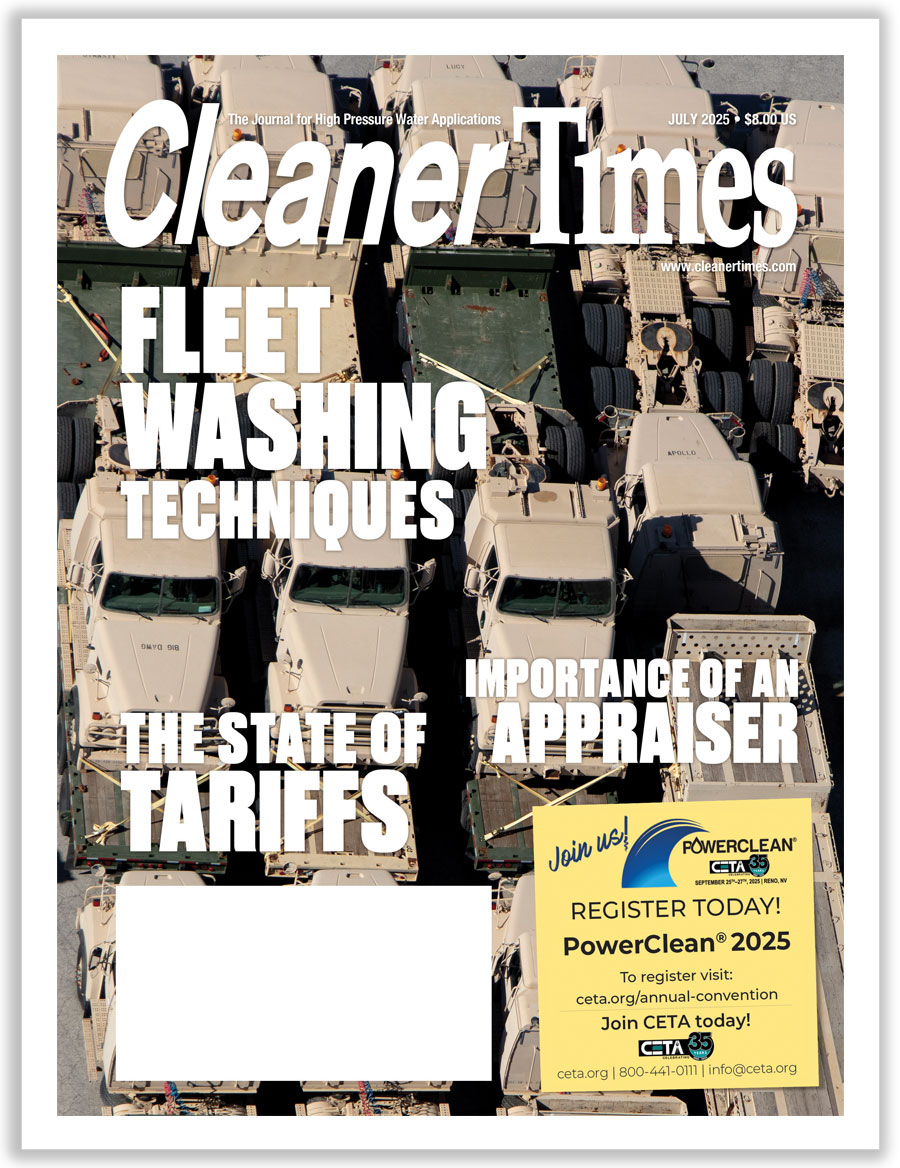
Recent Trends, Part I: Legislative and Regulatory Updates
Published May 2015

Many readers attended Dr. Marlo Dean’s presentation on Regulations and Compliance at the November 2014 meeting of the Cleaning Equipment Trade Association (CETA). Seeking updates, we recently put questions to Dr. Dean, the senior support services manager at Kärcher North America in Camas, WA, who responds.
CT|IWA: Which voluntary regulation is most important for manufacturers and distributors to follow?
Dr. Dean: The only voluntary regulation is the Department of Energy (DOE) 10 CFR 430 regulation, which deals with efficiency. I classify this as voluntary because there is not a category under the DOE for pressure washer equipment. The fear is that, as in the past history of our industry, we will be classified as a boiler, and we will fall into the efficiency standards for boilers and process heaters, which in 2015 is 82 percent for natural gas/propane and 84 percent for oil-fired equipment calculated as AFUE [annual fuel utilization efficiency].
My concern is ENER-G in the EU, which has adopted the European Cleaning Machines Association (EUnited) nine percent thermal energy loss in exhaust gas on machines over 170,800 Btu, making it mandatory by 2020. Environmental agencies keep informed of these changes and are known to make amendments to include these changes. This could be a requirement by the DOE in the near future, thereby placing pressure washer equipment on their list of regulated equipment.
Dean reminds us never to lose sight of mandatory regulations with two examples. One, OSHA (Occupational Safety and Health Administration) and CCOHS (Canadian National Centre for Occupational Health) regulation 1910.399 and 1910.303(a) mandates equipment used in the workplace must be “listed” by an “approved” testing agency to industry safety standards. Compliance enhances worker safety and manufacturers gain liability protection.
Two, the Clean Air Act Amendment of 1990 of the Clean Air Act of 1970 (CAA) requires manufacturers to register equipment pursuant to section 213 CAA, or 40 CFR part 90, 1054, 1045, and part 1060. Manufacturers must obtain an evaporative/refueling family number. A manufacturer receives a certificate of compliance from the United States Environmental Protection Agency (EPA) each year. (To sell products in California, it is necessary to comply with the evaporative emission standards (Title 13, section 2754(a) or 2754(b)), as applicable, and register equipment obtaining an executive order (EO) to demonstrate compliance.)
CT|IWA: After talking with CETA members at the November meeting, is there a topic you would have added?
Dr. Dean: One topic that could have been added was Conflict Minerals provision under the Dodd-Frank Reform and Consumer Protection Act of 2010. This requires publically-traded companies to work proactively with their suppliers to ensure that products they purchase do not contain any conflict minerals that are directly or indirectly benefitting armed groups in the Democratic Republic of the Congo (DRC) or adjoining countries. Companies must declare that, to the best of their knowledge, their products do not contain any of the following conflict minerals or their derivatives: gold (Au), tantalum (Ta), tungsten (W), and tin (Sn).
Another topic would have been WERCSmart a division of UL involved in the registration of the new harmonized MSDS information or SDS information. (Editor’s Note: See “Recent Trends, Part II: MSDS to OSHA SDS and GHS” in the June issue of CT|IWA.)
CT|IWA: How do you recommend choosing an NRTL (nationally recognized testing laboratory)?
Dr. Dean: I select the NRTL by location—to save on transportation costs—and ease of doing business. I have worked with UL, CSA (Canadian Standards Association), and Intertek Testing Services (ETL) and selected the NRTL that responded to my request of getting our products tested in the least amount of time. All NRTLs are discreet and have standard operating procedures to prevent problems associated with this type of business.
(Dean adds NRTLs price services comparably. Establish a good relationship and price negotiation may be possible. It’s easier to respond to a local NRTL if variations are reported, thus keeping project completion and market launch timetables firm.)
CT|IWA: When do you expect UL 1776 to be fully harmonized to UL 60335-2-79?
Dr. Dean: We met at the UL office in Northbrook, IL on March 26, 2015, to discuss the final public hearing issues submitted. I expected to be finished two years ago. When harmonizing to an IEC standard, when they make changes, it triggers a review by our UL committee, which requires public comment and the project continues. I hope we can finalize and come to a final conclusion. (Editor’s Note: At time of publishing the May issue of CT|IWA, we did not have access to the results of the UL meeting in IL.)
CT|IWA: The International Electro-technical Commission standard IEC 60335-2 79 applies to equipment that meets ISO standards. But the harmonized UL 60335 2-79 will not be identical to the existing IEC 60335-2-79. What are the differences that must be reconciled?
Dr. Dean: ISO (International Standards Organization) is about policies and procedures, not equipment. IEC (International Electrotechnical Commission) is an international body similar to ANSI (American National Standards Institute) in that they publish safety standards for equipment or products.
The UL 60335-2-79 will be drafted mostly around the IEC 60335-2-79. Included in the UL 60335-2-79 are the national differences like the U.S. requirement by the NEC® (National Electric Code of National Fire Protection Association) to have a GFCI (ground-fault circuit interrupter) on a pressure washer 250 volt or less single phase. If there is a specific requirement or safety issue not included in the IEC standard, the committee adds these requirements as a national difference, making the IEC and UL versions different.
CT|IWA: CETA is working with Intertek (ETL) to verify its efficiency standard to comply in 2015 with DOE 10 CFR 430. How is the work going?
Dr. Dean: CETA finished a rough draft last year. CETA will be prepared to implement their efficiency standard when the DOE places a requirement on pressure washer equipment. Hav-ing a draft copy will allow CETA to lobby the DOE to adopt an efficiency standard developed by our industry for our industry and allow some compromise.
CT|IWA: If a manufacturer meets the EO (executive order) from California, which is more stringent than the U.S. EPA Certificate of Conformity (applies in the other 49 states), is the EO accepted by all states?
Dr. Dean: The CAA requires all states to adopt regulations for compliance. California is the state because of the problems it faced with air pollution established regulations …more restrictive than…federal regulations… An EO from California will not be accepted by other states. States may adopt all or part of the California regulations, but they will establish their own regulations and compliance procedures with penalties.
CT|IWA: Must existing and non-com-pliant pressure washers be made compliant with EO or U.S. EPA Certificate of Conformity when they are brought to a distributor for service?
Dr. Dean: A dealer is not required to modify or change a machine to bring it into compliance. If a manufacturer has been selling equipment that is not in compliance and is not registered, the EPA expects the manufacturer to issue a notice offering the dealer compensation to install a kit free-of-charge to update any machine, which was not in compliance since from the date of regulation enforcement.
Dr. Dean amplifies, noting manufacturers must publish and provide a defined warranty statement and warranty time period of two years for evaporative emission components. When performing service, a dealer must replace and repair any evaporative component as listed in the warranty policy.
CT|IWA: Must repair of existing engines at service centers include EMC testing?
Dr. Dean: No, electromagnetic compatibility pollution (emission) is the unintentional generation, propagation, and reception of electromagnetic energy. This is an EU directive started by a German Law (1995) that has been adopted but… not being pushed in the United States. Engines must be designed to prevent EMC interference and engines are available that have passed the EMC testing and are labeled with the C-Tick logo.
Dr. Dean explains EMC testing should be integral to the design and development process. His company sends equipment for EMC testing. If there is a failure, shielding is placed around ignition wires and other components, which most likely produce electromagnetic energy.
CT|IWA: Why are Canada and the United States the only countries that have not completely adopted the IEC safety standards?
Dr. Dean: UL was formed in the United States as a non-profit organization in 1894 and has locations in 104 countries. The IEC was formed in London, England in 1906 as a non-government organization. CSA was organized in Canada in 1919 as a non-profit organization. CSA and UL develop their own standards and like the current UL-1776 to UL-60335-2-79 harmonization project will use sections of the IEC and vice versa. UL was the first organization established to write safety standards and testing out of the need to save lives. The others followed.
Dr. Dean believes IEC grew rapidly after the EU formed and following the IEC standards simplified selling in the EU. When shipping to any EU country, his company follows the EU directives and CE labels its equipment. Following a UL or CSA standard will unlikely meet EU directives because harmonization to an IEC safety standard is not complete.
The foregoing is the main reason CETA is pushing for the harmonization of the UL 1776 pressure washer standard with the IEC 60335-2-79.




